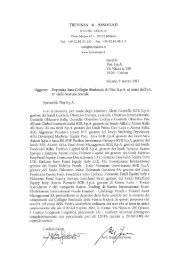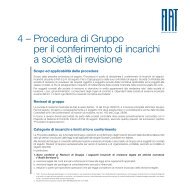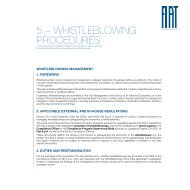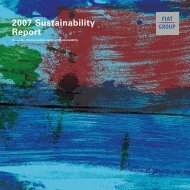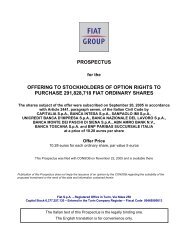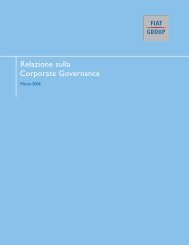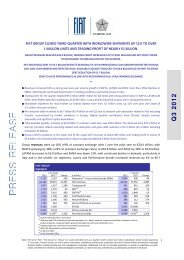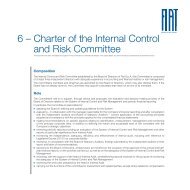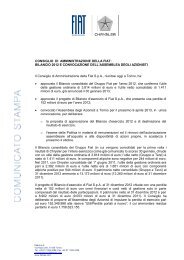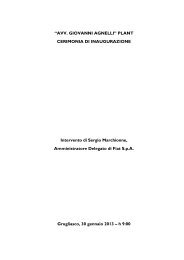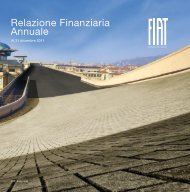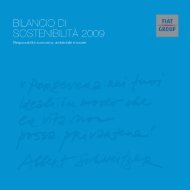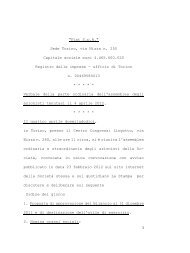annual report - FIAT SpA
annual report - FIAT SpA
annual report - FIAT SpA
You also want an ePaper? Increase the reach of your titles
YUMPU automatically turns print PDFs into web optimized ePapers that Google loves.
Format of the financial statements<br />
The Group presents an income statement using a classification based on the function of expenses (otherwise known<br />
as the “cost of sales” method), rather than based on their nature, as this is believed to provide information that is more<br />
relevant. The format selected is that used for managing the business and for management <strong>report</strong>ing purposes and is<br />
consistent with international practice in the automotive sector. In this income statement, in which the classification of<br />
expenses is based on their function, the Trading profit/(loss) is <strong>report</strong>ed specifically as part of Operating profit/(loss)<br />
and separate from the income and expense resulting from the non-recurring operations of the business, such as<br />
Gains (losses) on the sale of investments, Restructuring costs and any Other income (expenses) defined as unusual<br />
and of a similar nature to these items. By doing this, it is believed that the Group’s actual performance from normal<br />
trading operations may be measured in a better way, while disclosing specific details of unusual income and<br />
expenses. Consequently, the definition of unusual transaction adopted by the Group differs from that provided in the<br />
Consob Communication of 27 July, 2006, under which unusual and abnormal transactions are those which, because<br />
of their significance or importance, the nature of the parties involved, the object of the transaction or the methods of<br />
determining the transfer price or the timing of the event (close to the year end), may give rise to doubts regarding the<br />
accuracy/completeness of the information in the financial statements, conflicts of interest, the safeguarding of an<br />
entity’s assets or the protection of non-controlling interests.<br />
For the Statement of financial position, a mixed format has been selected to present current and non-current assets<br />
and liabilities, as permitted by IAS 1. In more detail, both companies carrying out industrial activities and those<br />
carrying out financial activities are consolidated in the Group’s financial statements. The investment portfolios of<br />
financial services companies are included in current assets, as the investments will be realised in their normal<br />
operating cycle. Financial services companies, though, obtain funds only partially from the market: the remaining are<br />
obtained from Fiat S.p.A. through the Group’s treasury companies (included in industrial companies), which lend<br />
funds both to industrial Group companies and to financial services companies as the need arises. This financial<br />
service structure within the Group means that any attempt to separate current and non-current debt in the<br />
consolidated Statement of financial position cannot be meaningful. Suitable disclosure of the due dates of liabilities is<br />
moreover provided in the notes.<br />
The Statement of Cash Flows is presented using the indirect method.<br />
In connection with the requirements of the Consob Resolution No. 15519 of 27 July 2006 as to the format of the<br />
financial statements, specific supplementary Income Statement, Statement of Financial Position and Statement of<br />
Cash Flows formats have been added for related party transactions so as not to compromise an overall reading of the<br />
statements.<br />
Basis of consolidation<br />
Subsidiaries<br />
Subsidiaries are enterprises controlled by the Group, as defined in IAS 27 – Consolidated and Separate Financial<br />
Statements. Control exists when the Group has the power, directly or indirectly, to govern the financial and operating<br />
policies of an enterprise so as to obtain benefits from its activities. The financial statements of subsidiaries are<br />
combined in the consolidated financial statements from the date that control commences until the date that control<br />
ceases. Non-controlling interests in the net assets of consolidated subsidiaries and non-controlling interests in the<br />
profit or loss of consolidated subsidiaries are presented separately from the interests of the owners of the parent in the<br />
consolidated statement of financial position and income statement respectively. Losses applicable to non-controlling<br />
interests which exceed the minority’s interests in the subsidiary’s equity are allocated against the non-controlling<br />
interests. Changes in the interests in a subsidiary which do not lead to the acquisition or loss of control are recognised<br />
directly in equity.<br />
Subsidiaries that are either dormant or generate a negligible volume of business, are not consolidated. Their impact<br />
on the Group’s assets, liabilities, financial position and profit/(loss) attributable to the owners of the parent is<br />
immaterial.<br />
Jointly controlled entities<br />
Jointly controlled entities are enterprises over whose activities the Group has joint control, as defined in IAS 31 –<br />
Interests in Joint Ventures. The consolidated financial statements include the Group’s share of the earnings of jointly<br />
controlled entities using the equity method from the date that joint control commences until the date that joint control<br />
ceases.<br />
Fiat Group Consolidated Financial Statements at 31 December 2010 112



